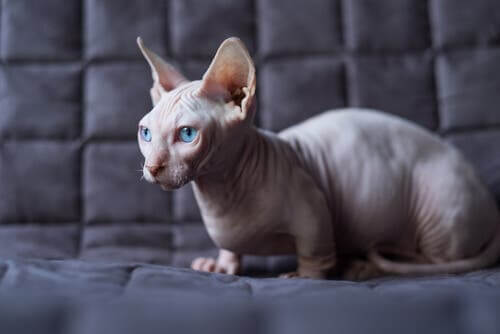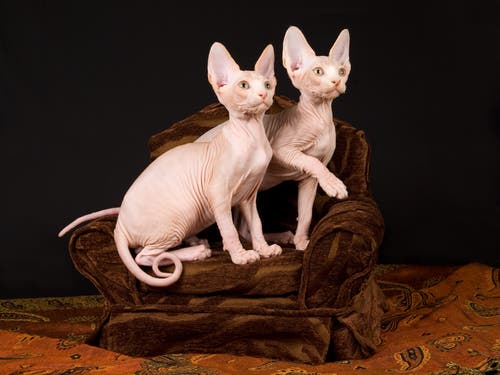How to Care for a Hairless Cat: Tips and Recommendations

Cats with no, or almost no, hair have become popular in recent years and many people choose to have them as pets. But although its appearance may give us the impression that it’s unprotected, a hairless cat is a healthy and strong feline. However, they do require specific attention. Therefore, today we’ll tell you how to take care of a hairless cat.
Considerations about a hairless cat
These feline breeds actually have a very thin layer of fur almost imperceptible to the touch and the human eye. In addition, they’re intelligent and curious cats, but they prefer to live in the tranquility of a home.
And, while their hair scarcity occurs naturally in cats because of a genetic mutation, the role that humans have played in generating different breeds of hairless felines is just as important.

Among them we can mention:
- The Sphynx or Sphinx
- Donskoy or Don Sphynx
- Ukrainian Levkoy
- Peterbald
- Bambino cat
- Elf cat
Tips for their general care
Hygiene and food are two fundamental factors to help your cat live happily and without any major problems. But above all, if you want to take care of a hairless cat you must always provide it with a place where they won’t suffer from cold conditions.
The ideal temperature for the animal to be at ease and safe from illness should not be less than 71°F. Moreover, logically your pet should never sleep outside the house. These cats are indoor pets, without a doubt.

As for their diet, it’s the vet who’ll know exactly which one is best for your hairless friend. However, a combination of wet and dry foods is usually an appropriate mix.
Your cat should also always be provided with clean, fresh water. The point is that because of its greater transpiration (a minimal amount of hair means they sweat just like humans) it’s at risk of dehydration.
If you want to take care of a hairless cat properly, you must be attentive to its food and hygiene, and always provide it with a place where it won’t get cold.
Skincare for hairless cats
Caring for a hairless feline involves paying close attention to their skin. Keep in mind that their skin produces sebum when they sweat. For this reason, it’s of utmost importance that the cat gets used to being bathed at least once every 20 days starting from a young age.
The veterinarian should point out the most suitable shampoo products to use on your pet. Moreover, before using it, do a little test to see how your pet’s sensitive skin reacts. And most of all, never use products meant for humans or other animals.

Don’t let your pet be exposed to sunlight for too long. Lack of hair predisposes them to sunstroke, burns, irritations, and even skin cancer.
On the other hand, remember to keep the spaces and beds they use clean. This will prevent dirt from sticking to their skin or infecting it with bacteria, fungi, or viruses.
We should also mention that despite them being hairless, parasites (both internal and external) won’t stop stalking them. Therefore, deworming and vaccination schedules must be met like with any other cat.
Eyes, ears and nail care
As you can see, having a ‘fashionable’ pet requires extra effort. The most important thing is that you have the willingness and responsibility to take on the special care required by your pet.
Another topic you need to have under control is their eye health. Pay close attention to whether they are watery or if they look like the cat’s hurting. Because they lack eyelashes (they’re almost invisible) it’s very easy for dirt to enter them and cause them to get an infection. Nevertheless, you can buy physiological serums to clean them and remove any dirt or unwanted materials.
Your cat’s ears are another area that you should carefully examine in search for any abnormalities. You will have to constantly use specialized products to remove dirt and accumulated wax. In addition, keep an eye on their nails also, as they can accumulate fat. Apart from regular hygiene, make sure to keep them short.
We should note that these cats accumulate a lot of dirt together in their ears. You’ll probably need to use a few specific drops which you can find in veterinary centers to remove the accumulated wax. In case you have any doubts that arise about how to better care for your hairless pet, don’t hesitate to ask your trusted veterinarian.